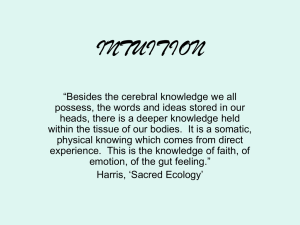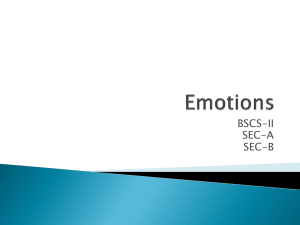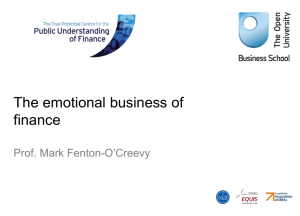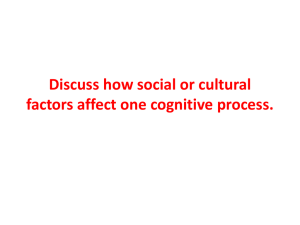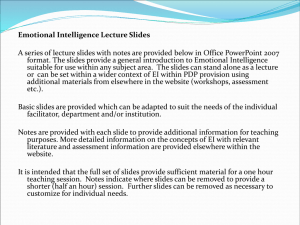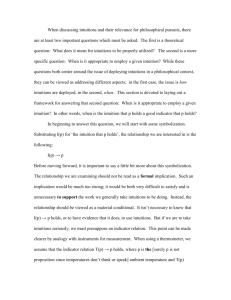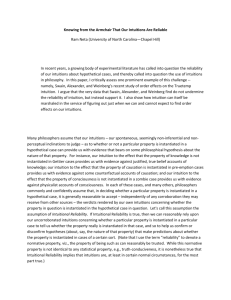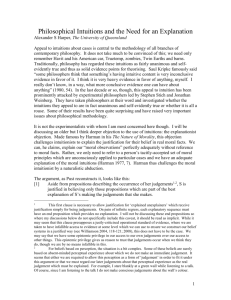TOK emotion powerpoint
advertisement
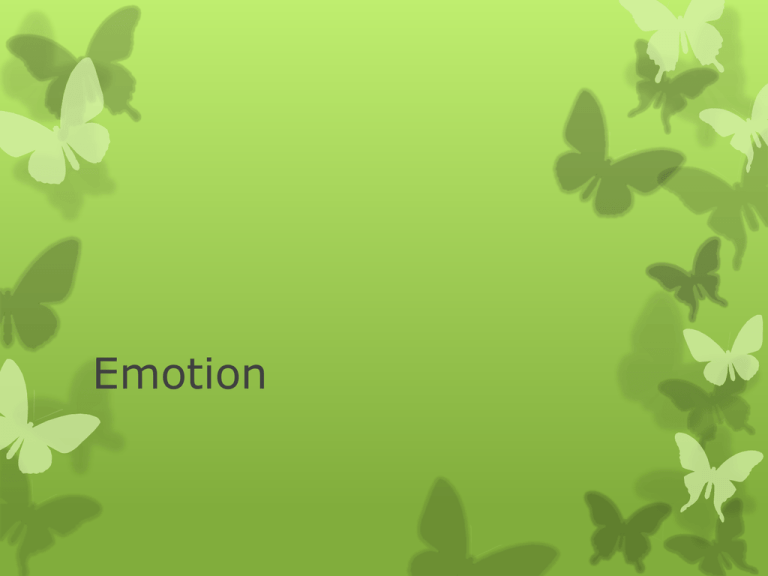
Emotion Guiding Questions… How do emotions interfere with how we view the world? To what extent can we control our emotions? How closely are reason and emotion related? Primary Emotions According to psychologists, there are 6 basic emotions. Happiness Sadness Fear Anger Surprise Disgust Which basic emotion is displayed? Which basic emotion is displayed? Which basic emotion is displayed? Which basic emotion is displayed? Are emotions innate or learned? No matter what country someone is from, they can identify the emotion on someone’s face. Children that are blind and deaf are able to show these emotions. Do different cultures have different rules about the extent to which one should display one’s emotions? James-Lange Theory The idea that emotions are essentially physical in nature, and bodily changes come before, and cause emotional changes. If you remove the physical symptoms the corresponding emotions disappear. The theory also suggests that is you mimic the appropriate physical symptoms you can generate the corresponding emotion. (If you smile you feel happy!) Imagine the following… You are about to take your Examen Quimestral. You are feeling very nervous. Your mouth is dry, you have a sinking feeling in the pit of your stomach, the palms of your hands are sweaty, and you want to go to the washroom. Now… remove each of these physical symptoms one by one. What is left of your Exam nerves? Enjoy! Empathy The identification with and understanding of another’s situation, feelings, and motives. James-Lange Theory also suggests that humans can empathize with other people’s feelings. Example: If someone explains some problems they are having, you may say, “I’m so sorry!” You may find yourself instinctively adopting their depressed tone and even posture. The role of beliefs… The James-Lange Theory can be argued against, because our emotions have a mental aspect, as well as a physical aspect. Our emotions can be affected by our beliefs. Social Emotions: emotions such as ambition, embarrassment, envy, gratitude, guilt, jealousy, pride, shame and sympathy Emotions as an obstacle to knowledge Emotions are likely to influence the way we see and think about the world. Strong emotions can sometimes distort the 3 other “ways of knowing”. Perception: “love is blind” Emotional Colouring: the idea that our perception of things can be hindered by strong emotions Reason: If you hold your beliefs with too much passion, it can prevent you from being open-minded. Language: Strong emotions can cause a person to use negative and/or emotive language Rationalizing a belief system The tendency to rationalize can lead a person to develop an illusory but self-confirming belief system. Example: Henry has an emotional prejudice against immigrants. His prejudice will probably lead to the following… Biased perception: He notices only lazy immigrants and overlooks the working ones, Fallacious reasoning: He makes hasty generalizations from his own limited experience. Emotive Language: He uses “strong and untrue language” to make conclusions about immigrants. (Emotive language is when someone uses words to purposely create an emotional impact) A world without emotions??? Since some emotions can distort our ability to think clearly and behave intelligently, you might think that the ideal situation would be one in which we did not have any emotions at all and could look at the world in a balanced and objective way. In ancient times, such a belief was held by a group of philosophers known as the stoics. Stoicism: a philosophy that promoted the lack of emotions Apathy: a lack of feeling, emotion, or interest/ “without passion” Emotions as a source of knowledge. It is difficult to imagine a meaningful human life without any emotions. If you describe someone as being ‘cold and unemotional’, you do not literally mean they have no emotions, but they have less emotions then the average person. Some people that seem to be lacking in emotion, are actually “in control” of their emotions. Rational Fool: a person that is indifferent to sensation and actually has no emotions. (due to brain damage) The relation between reason and emotion. Reason and emotion are closely related to one another. Rather than think of reason and emotion as completely different “either-or” things, it makes more sense to say there is a continuum running from the very rational to the very emotional. Intuitions Definition: a type of feeling that is effortless and immediate; an automatic feeling or thought There are a variety of types of intuitions, so we will break them into 3 different types: Core intuitions Subject-specific intuitions Social intuitions Core Intuitions In an abstract sense, it could be argued that all of our knowledge is based on intuition. Reason and Perception ultimately depend on intuition. Reason: The laws of logic are the starting point for all our reasoning. In order to prove these laws, we often say that they are intuitively obvious. Perception: This is an important source of knowledge, but we cannot always be sure on the evidence of our senses alone that life is not a dream. Yet we have an overwhelmingly strong intuition that we are actually experiencing reality. Subject-specific intuitions We sometimes use intuition to justify our knowledge claims in various areas of knowledge, but this can sometimes pose problems. We must remember that intuitions (like common sense) can vary from person to person, so use them with caution. Debugging intuition: removing the flaws of intuition Social Intuitions We tend to put a lot of trust in our intuitions about other people and we pride ourselves on being good judges of character. However, the evidence suggests that our intuitions are not as good as we like to think. Natural and Educated Intuitions Natural Intuitions Educated Intuitions Expert opinion can often be determined by intuitions. Example: A master chess player These do not always help us understand the world. They will survey a chessboard and intuitively see the right move to make. Their intuition is a combination of raw talent and background knowledge. How reliable is intuition? Educated intuition is generally more reliable than natural intuition. Since good intuitions are not always reliable, we must test them against other sources of knowledge. If your intuitions coincide with reason and experience and other people’s intuitions, then it makes more sense to trust them than if they do not. Example: When deciding between two University’s to attend, reason and intuition may contradict one another. In the end, most people tend to go with their intuitions.

